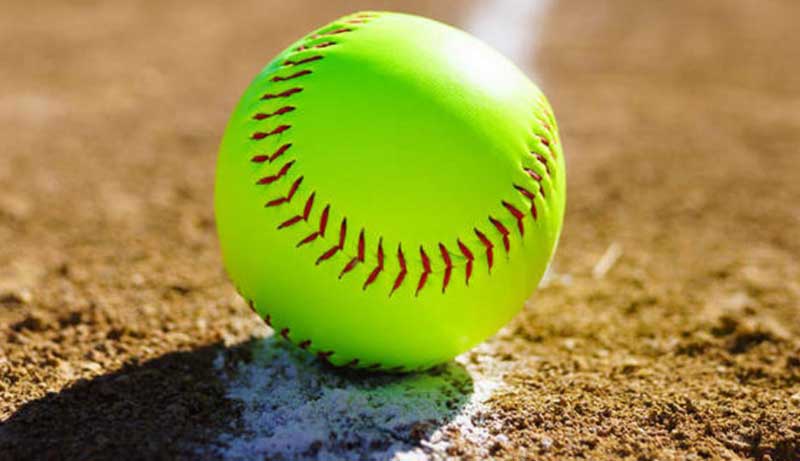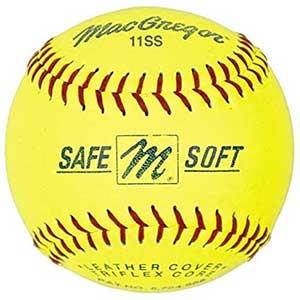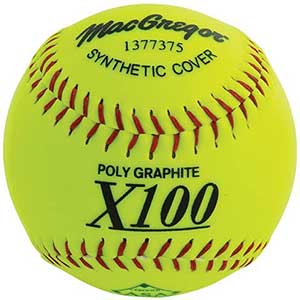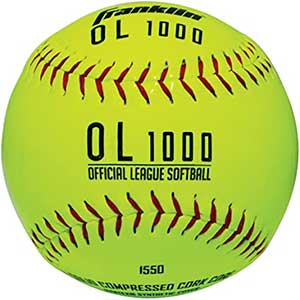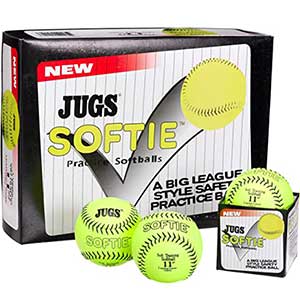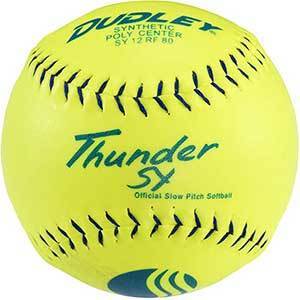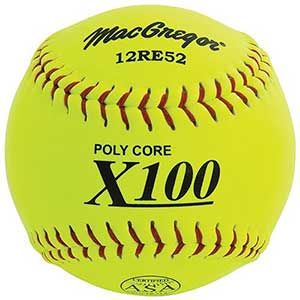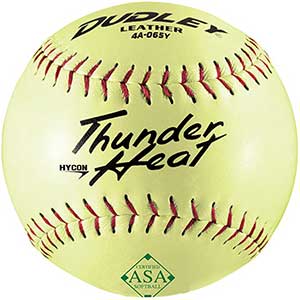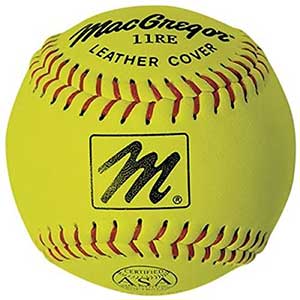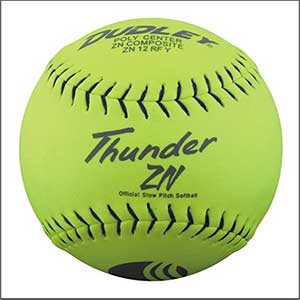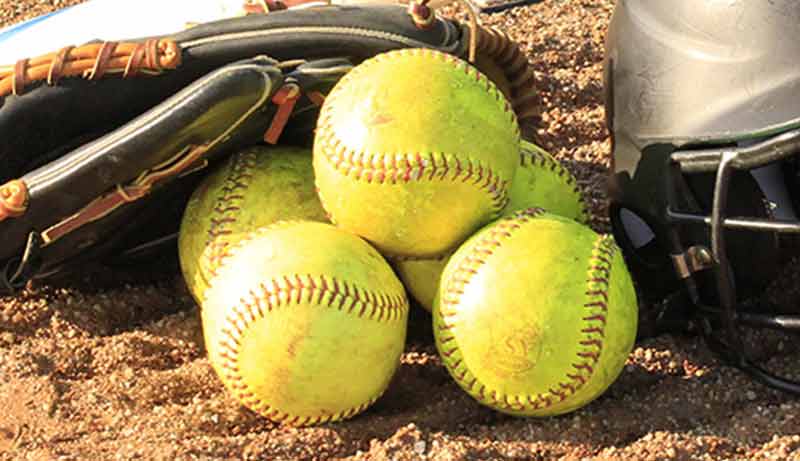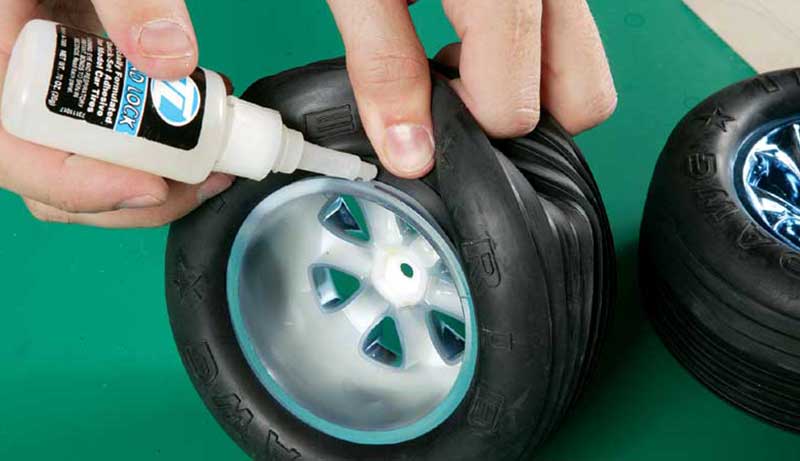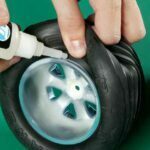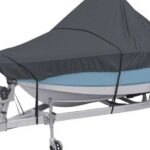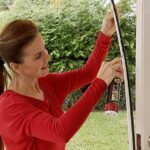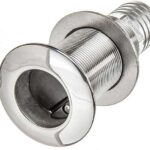Even the best slowpitch softballs may initially appear to be very affordable when compared to bats, gloves, and shoes. Yet for slow pitch, you can’t just use one of these softballs. For games, you’ll likely need a dozen of these, and you might need more for practice.
The cost of the softballs will increase over the course of a season because they could not last very long at all. You can at least enjoy them for one season if you have nice gloves and bats. With a softball, it isn’t actually the case.
Yet, don’t all softballs look the same? That’s not really accurate. For various leagues, you could have different balls. For your upcoming league or practice sessions, we have found some of the greatest slowpitch softballs.
Our Best Slow Pitch Softballs Reviews
1. Dudley USSSA Thunder ZN Slowpitch Classic M Stamp Softball
When you ask a softball player (or a baseball player, for that matter) about their dreams during the game, the likelihood is that they will mention hitting the winning home run. Even a routine home run is entertaining because the player may take his time going around the bases as his teammates wait to congratulate him at home plate.
If you’re the hitter, your chances of seeing that dream come true with this softball are very good. These balls fly like crazy. This ball is not inherently flawed or unfair in any way. The reason it is regarded as the best USSSA slowpitch softball is because it is the Classic M softball.
The materials and design of the object are essential to its capacity to fly. As a player strikes the ball, the polyurethane core provides loads of energy. Moreover, the composite cover is incredibly thin, allowing the force to reach the core much more quickly.
This softball is enjoyed by everyone, not just the hitters. As long as they don’t go beyond the bounds of a home run, fielders also enjoy them. While it flies or is lying on the grass, the neon hue is rather simple to follow. Fielders and pitchers won’t have any trouble throwing the ball because it’s comfortable to hold.
Everyone on the two teams will appreciate it if you switch out the softballs you typically use for your games. Simply put, it’s excellent and improves everyone’s gameplay. Everyone feels happy and enjoys the game when they hit harder and field more correctly.
Get this for your team’s exhibition games as well so that they may get a good feel for the game’s environment. Also, even after playing too many games, these balls can still be used for batting practice.
Key Features
- 40 COR at 12 inches, 325 compression rating
- ZN composite cover that is incredibly thin
- At the center, a precisely blended cross-linked polyurethane material
- conforms to USSSA
- smooth seams
- Luminous neon with teal writing
2. MacGregor Safe/Soft Training Softballs
The majority of coaches disagree that practice balls should be made of standard balls. After all, the ball won’t be hit as frequently in a genuine game as it will be in your practice games. Younger players may not want to play the game if they are hit even once by a practice ball since regulation balls may be too hard for them.
In addition, practice balls that are not legal are far cheaper than official balls. Purchasing official balls for practice seems to be the complete opposite of economical.
Why not purchase these soft and secure training softballs from MacGregor for your practice? These fit your budget perfectly because they aren’t too pricey. Also, these slowpitch balls are made to last for a very long time and are quite durable.
When you encourage young players to practice their fielding drills, this is fantastic. They can focus on what needs to be done without being distracted by thoughts of how painful it would be if they were ever struck by the softball. The Tri-Flex safety core makes the softball less rigid than a standard ball.
The leather cover is great for fielding drills as well. Fielders are able to make better catches and throw more precisely because they are simpler to grip. The “feel” of the ball is comparable to that of a traditional softball.
You ought to think about using this ball indoors as well. The gym walls or flooring won’t be harmed by the ball because of how soft it is.
Overall, as they hone their talents, your players will prefer to practice with these softballs. These slowpitch softballs are the finest for practicing because of their softness, amazing feel, all-around toughness, and great affordability.
Key Features
- sizes 11 and 12 inches readily available
- has a “Tri-Flex” safety core with a leather cover.
3. MacGregor X52RE ASA Slow Pitch Synthetic Softball, 12-Inch
Softball teams typically follow the practice of using more expensive balls for practices and real regulation softballs for the actual games. When transitioning from practice to actual games, using different balls is typically required, which presents challenges. The various balls utilized can feel too strange.
But now that you have slow pitch softballs that have received ASA approval, you can also use them for practice. They are really affordable, and the pricing for a dozen is very fair.
The fact is, these balls can actually fly. That makes for thrilling games as well as fantastic batting practice. When the ball travels farther, it gives hitters such a wonderful feeling.
You’ll also be impressed by its toughness. These softballs are extremely resilient, keeping their shape and characteristics even after being struck several times. When your players hit more home runs and you can get them back and utilize them again, batting practice can be rather enjoyable.
Key Features
- A yellow ball with red stitching and black design, 12 inches in diameter, and 52 COR rating with 300 maximum compression
4. Franklin Sports Practice Softballs – Official Size and Weight Softball
When you’re unsure of what to buy, you might sometimes just want to believe what other people are buying. Although it might not always be a smart idea, using these Franklin Sports slowpitch softballs for practice is effective. In their genre, these are the bestsellers. The affordable price is obviously a contributing factor to its appeal, but there are other benefits as well.
This softball practice game is intended to assist you (the coach) in teaching your players how to improve their fielding abilities. Your players can follow the ball well as it flies through the air or bounces across the field thanks to the bright yellow color. Whether you’re playing in the daylight or under the stadium lights, the softball is simple to see. When it’s on the field, it will be clear to see.
Fielding practice is also made easier by the flat seams. This is because the flat seams lessen the resistance the ball experiences when being hurled into the air. Because of this, your fielders can throw the ball farther since it flies through the air more smoothly.
Your fielding drills can be applied to actual games because the ball has the appropriate size and weight. As your players learn to field their position, you can also improve their movement abilities. Even if you utilize the official balls, the game’s circumstances won’t feel all that different.
Key Features
- a 12 inch
- equivalent to official regulation softballs in terms of size and weight
- smooth seams
- core of solid cork
- a robust synthetic cover in the color “Optic” yellow
5. Jugs Softie Practice Softballs
What justification could there possibly be for increasing the cost of practice softballs? Jugs’ practice slowpitch softballs are the ideal way to demonstrate why you could consider doing that for your softball team.
First off, these balls have many characteristics with standard balls. The 11-inch and 12-inch sizes are the same. Both the stitching and the leather on the cover are authentic. When a player fields it and strikes it, it feels the same. The fact that the balls feel the same means that the techniques you learn can be applied to real-world situations.
Nonetheless, as a coach, you’ll enjoy the genuine softness of these softballs. At the very least, these won’t damage your metal bats. It is constantly a valid worry during batting practice. For batting practice, some instructors instruct their players to use various bats; but, when it comes time to play, the aluminum bat doesn’t feel as comfortable. They can use the same bats with these balls.
Likewise, your school won’t mind if you practice your fielding indoors. The slowpitch softballs are physically soft enough not to leave scuff marks on the gym floors.
Finally, these softballs can last a complete season. Therefore it suggests it’s probably a cost-effective solution. You won’t have to buy replacements for your softball practice balls too often.
Key Features
- 11 and 12 inch diameters are offered (same size as regulation balls)
- The cover is made of genuine leather with actual stitching.
- softer in feel
- The balls still feel normal.
- Not going to harm your aluminum bats
- Will not scratch gym floors
- For usage either inside or outside.
6. Dudley USSSA Thunder SY Slowpitch Classic M Stamp Softball
As we’ve already featured the Dudley USSSA Thunder ZN Slowpitch Classic M Stamp Softball, it could appear that this softball is making a repeat appearance on this list. Yep, just like the preceding Dudley on this list, this is USSSA-certified and counts among the top USSSA slowpitch softballs. These two even have the same price.
In its core, this also contains perfectly blended cross-linked polyurethane. The pop you need to make the softball fly off the bat is provided by this core. Because of the flat seams, there is less friction when the ball flies through the air. It is fairly dense and highly durable.
Yet if you examine the name more thoroughly, you’ll see a subtle distinction that results in a significantly different performance. This is due to the ZN being the earlier model. The SY model is this. These names designate the cover material. For the ZN, Dudley employed ZN composite material. The cover of these SY slowpitch softballs is made of synthetic material.
This indicates that the cover in this instance actually appears nicer. The synthetic feels wonderful too. Finally, the ZN is primarily designed for warmer climates. The SY performs well in cooler climates.
Key Features
- available in a 12 inch size
- USSSA slow pitch softball accreditation
- has carefully combined cross-linked polyurethane for more pop in the core.
- Flat seams reduce air turbulence
- In chilly areas, the synthetic cover feels nice and performs better.
7. MacGregor X52RE ASA Slow Pitch Composite Softball, 12-inch
You might assume that this is yet another best slowpitch softball that was unintentionally replicated. After all, it’s another MacGregor X52RE ASA Slow Pitch softball. Even the size, which is 12 inches, is the same.
This has a composite cover, which explains why. Actually, the composite is an improvement above the synthetic cover. The best cover material is real leather only. Even still, the composite has a pleasant feel and contributes to the ball’s increased durability. Your players can really make the ball fly when they hit this since the force of the bat also strikes the core of the ball more effectively.
This has a lovely golden tint that is noticeable both in natural light and when illuminated by stadium lights. On the grass, players can find and track the ball with relative ease.
Moreover, throws are more effective thanks to the flat seams. In order to allow players to throw the balls farther, air friction is reduced.
The good news is that these softballs are not only inexpensive, but also incredibly resilient. This means you can utilize them for practice without significantly depleting your cash. The softballs your team uses for actual games can then be used for practice. That undoubtedly helps because they won’t have to get used to new balls when playing in actual league games following practice.
Key Features
- 52 COR rating, 300 maximum compression rating, and approved for ASA slow pitch softball Poly graphite core
- A yellow ball with black writing and red stitching
8. Dudley ASA Thunder Hycon Leather Slowpitch Softball
This is the leather version of the softball; the synthetic and composite versions have already been listed. The leather is the best, followed by the synthetic, composite, and (in some ways) the composite.
This leather cover is excellent since it gives your pitchers and fielders a more secure grip. They have a particular grip that allows them to throw more precisely. The fielders are better able to toss the ball where they want it to go because of the flat seams’ increased distance and grip assurance.
The cover is also quite durable. These slow pitch softballs perform admirably and are frequently used in men’s leagues.
This has a lot of pop and is comparable in size to nerf balls to certain other softballs. Regardless of how warm or cold it is where you are playing, the compression doesn’t change. Your aluminum bats will benefit greatly from the lower compression. These bats won’t need to sustain dents during drills. You won’t need to insist that your players utilize various bats during batting practice.
You should definitely take a look at this one if you’re looking for the greatest slowpitch softballs. It is essentially the same softball that professionals use.
Key Features
- 12 inches, 52 COR rating, and 300 maximum compression rating
- Flat seams to lessen air turbulence
- For continuously reduced compression, use Hycon Poly-Core.
- Cover in leather
- meets the requirements of the most recent ASA
9. Macgregor X44Re Asa Slow Pitch Softball
Do everyone a favor and obtain this ball if your league abides by ASA rules. It is after all ASA-approved. All of the participants will, however, concur with this. Considering how cheap they are in comparison to other softballs, you might even buy them for practice.
Your fielders will love how the leather cover feels in their hands. Moreover, it makes the ball tougher so that it can withstand practicing sessions.
With its raised seams, the leather cover is excellent for pitchers as well. The game may become more difficult for hitters as a result of these seams, which can allow the softball to go in more unpredictable routes.
The harder the softball, indicated by the higher compression value, the farther it will likely travel. That’s also fantastic for batters, who naturally like to hit a home run.
Coaches, batters, fielders, and pitchers all adore this assortment of the best slowpitch softballs because it has ASA approval.
Key Features
- ASA-approved
- 11 inches of leather
- Cork core with a maximum compression rating of 375 and a COR rating of 44
- traditional raised seams and red stitching
- Cover in neon yellow
10. Dudley USSSA Thunder ZN Slow Pitch Softball – .47 COR – Stadium Stamp
You need durable softballs for men’s softball leagues so they won’t be destroyed the first time a powerful hitter smashes them. Since it is the official softball of the USSSA men’s conference, this is the one you need.
The compression rating on this ball is 450, making it a very challenging pitch. That is encouraging for its robustness. Also, it implies that the ball will actually fly. Because you need bigger spaces to keep the ball in the ballpark, it is designed for stadiums.
It’s also fantastic that the composite cover lasts longer than the synthetic cover. The force can also move swiftly to the core thanks to the ZN composite.
Key Features
- stadium logo (instead of Classic M stamp)
- 12 inches ZN Official USSSA Men’s Conference Ball 47 COR composite cover with 450 compression rating
Factors to Consider Before Buying Slow Pitch Softballs
It’s advisable to verify the specs of the best slowpitch softballs, just to make sure you know what you’re buying. You can then acquire the size along with the technical parameters that can inform you how the softball will perform.
You should check out user reviews as well, to offer you a more accurate overall assessment on the quality of the softball. Consumers tend to offer more objective assessments.
When you study the specs and evaluations, pay particular attention to the following factors:
Cost
Most softball teams don’t have infinite budgets, so if you’re in charge of buying the softballs then you have to pay attention to the pricing. You have to understand that higher-quality balls will cost more.
Yet, you might obtain huge discounts if you buy by the dozen. Occasionally you can cut down the price by $1 each ball.
Type
The sort of ball you get will undoubtedly effect the cost of the softball.
Regulation Softballs
They will be the most expensive. These are the best slowpitch softballs you use for genuine games.
The best approach to check if your slow pitch softballs are approved for play is to look for the insignia of the organizational body that your league follows. Many softballs are stamped with the emblems of entities such as the United States Specialty Sports Association (USSSA), the National Softball Association (NSA), and USA Softball.
Please remember that your ball must also conform with your league requirements about COR, compression, and softball size.
Dimpled Softballs
They have no seams but instead have enormous dimples. They are specifically built for automatic pitching machines since softballs with seams can cause harm to the pitching machine.
Training Softballs
They are meant for softball pitchers. These training softballs are heavier than standard balls, and that assists pitchers to enhance their arm strength. Generally these appear in blue or green colors, to separate them from the normal game balls.
Practice Softballs
These are the cheap softballs constructed from low-quality materials. They’re mainly just for batting and fielding practice.
Safety Softballs
Often dubbed “non-traditional” softballs, these are generally for younger youngsters. These balls are softer on the outside, which can lessen the damage and discomfort if the ball impacts a player accidently. The unusual design makes these slowpitch softballs as pricey as regulation softballs.
COR and Compression Ratings
The slow pitch softballs you buy for game use must correspond to the COR and compression specifications given by your league. These ratings are often printed on the softballs, which the umpire will examine. If the necessary markings aren’t there, then the umpire won’t authorize the usage of the ball.
Compression
The compression rating can be 275, 350, 400, or 525 pounds. Sometimes the “pounds” are left off, but you know these are for the compression. This grade reflects the amount of force needed (in a number of pounds) to compress the softball by ¼ of an inch.
A higher compression value suggests a tougher core inside the softball. It means the ball is more likely to move farther when it’s hit.
COR
The COR rating stands for the coefficient of restitution. This will tell you about the bounciness or the liveliness of the ball. Common COR ratings include 40, 44, and 52 (but in many situations they’re written as .40, .44, and .52).
The higher COR rating such as the 52 suggests the ball bounces more when it hits the bat, which means it leaves the bat more rapidly and will go farther.
Size
The size of the slow pitch softballs measures its circumference, and this can go from as large as 16 inches down to as tiny as 11 inches.
16 Inches
This is a relatively safe ball to use, which is why it’s often seen in some wheelchair and senior slow-pitch softball games. The enormous softball doesn’t go fast off the bat, and the sluggish pace increases the safety. In certain games with 16-inch slow-pitch softballs, fielders don’t use gloves.
14 Inches
This is more for recreational softball games, while some softball leagues allow this size of a softball. It’s still safer than the little softballs since it’s larger. The ball doesn’t travel as swiftly off the bat as the smaller softballs. In addition, the ball doesn’t travel farther thus it’s less likely to be lost beyond the wall.
12 Inches
This is the standard ball size used for slow pitch and fastpitch softball. Young players often start using this ball when they’re 10 years old.
In some coed games, this is the size of the ball used to pitch to male players while the ladies utilize the smaller softball. This gives gender parity to account for the larger average strength of the boys.
11 Inches
This is generally the smallest softball-size you’ll see in a game. It’s utilized for female hitters in coed sports because it travels quicker and farther than the 12-inch slow-pitch softballs.
In some circumstances, the ball is utilized for players 9 years old and younger. That’s because the smaller size of the softball enables a better fit with the children’s small hands.
Cover Material
The cover of the slow pitch softballs for slow pitch may be manufactured from either authentic leather or synthetic material. The genuine leather is normally more expensive, but then it gives more advantages. Lots of players choose for real leather since they have a more certain grip, and you’ll notice this more in damp circumstances. Real leather also lasts longer on average than synthetic leather.
Seams
You’ll want a high-quality seam on the slow pitch softballs to make sure they don’t unravel too rapidly. Fielders and pitchers tend to like raised seams on the cover. They obtain a surer grip when catching and throwing the ball, and pitchers find it easier to put a spin on the softball.
Core
The producer may put in rubber, cork, polyurethane, or a combination of these materials in the core. This result in varied COR and compression scores. Certain materials, such as high-density polyurethane, can help make the ball endure a lot longer.
Color
Many of practice balls come in a distinct hue, such as green or blue. This is especially true for the heavier-than-usual balls used for pitcher training. That’s so you can tell them different from the regulation slowpitch softballs, which have to be yellow according to NCAA guidelines.
Yet, there are different colors of yellow. Most players enjoy the brighter hues, since they’re easier to see on the field and in diverse lighting conditions. It makes them simpler to hit for batters, and easier for fielders to find.
FAQ – Frequently Asked Questions & Answer
1. Why these slowpitch softballs are yellow?
For the same reason, tennis balls are likewise yellow—you’re able to see them better. This helps the batter hit the softball, and fielders are quicker to track the ball after a hit.
That makes for a better game, which is why the NCAA chose bright yellow the official color of their softballs in 2002.
2. Why is a softball bigger than a baseball?
It’s a safer alternative, especially in light of how softball fields are smaller than baseball fields. The bigger softball doesn’t go as fast after a hitter hits it, and players aren’t able to toss the ball as forcefully as they would with a baseball. If the ball hits a player, the resulting injury won’t be as serious.
3. What type of softball should a team use?
That depends on what the squad is using a softball for. In general, you should utilize regulation slow pitch softballs for actual games, and they must be certified for your league. You can also utilize non-regulation balls for hitting and fielding practice.
4. How long will a softball last?
That depends on the initial quality of the softball, and how many times it’s been hit. Most decent quality softballs can be hit many dozens of times before you need to replace it.
Inexpensive slow pitch softballs may not last as long. These balls may develop dents or lose their shape more quickly. Seams are particularly more vulnerable. The seam thread may break or fall loose, and a hole in the seam can get wider.
It’s time to replace the softball for games if you find nicks in the softball cover. Yet, these can still be utilized for batting practice.
Final Word
It’s not a softball game without a softball. For the best games and for fruitful practices, you need the best USA slowpitch softballs or the ASA authorized softballs.
Get the greatest slowpitch softballs for your team, and you’ll find them enjoying the game more. You’ll also like how these balls can assist your players hone their slow pitch softball skills!
Related article: How to Finding the Best Fastpitch Softball Bats for 10u

